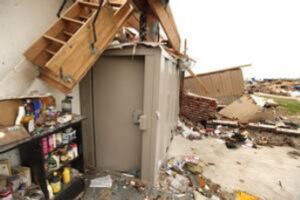
Thursday, May 30, 2013, Photo by Paul Hellstern,
The Oklahoman
BY BRYAN DEAN bdean@opubco.com • Modified: May 31, 2013 at 10:06 pm • Published: May 31, 2013
Part of the terror of an EF5 tornado like the one that hit Moore on May 20 is the notion that nothing aboveground can survive a direct hit and the 200 mph winds that rip homes off foundations.
But that’s not exactly true. Above ground storm shelters held up exceptionally well in the tornado and could be a better choice than a traditional underground storm cellar, said Larry Tanner, a research associate at the National Wind Institute at Texas Tech University.
Tanner was among a team of researchers from the institute that toured the damaged areas after the Moore tornado. They examined how different types of structures held up in the storm, with particular attention given to storm shelters.
The institute tests and approves shelters for manufacturers based on standards set by the Federal Emergency Management Agency. They use giant air cannons to fire debris at speeds simulating strong tornadoes.
Tanner said researchers found 16 aboveground safe rooms or storm shelters in the damage path or near the damage path of the storm. All survived.
“They all performed great,” Tanner said. “We continue to have great success stories both in Joplin and in Oklahoma City.”
In some cases, all that was left after the tornado passed were the shelters. Tanner said aboveground shelters have had a hard time catching on in Oklahoma, where people have been told for decades that the safest place during a tornado is underground.
Moore Emergency Manager Gayland Kitch said there are 3,170 storm shelters registered in Moore. The vast majority are below ground.
Tanner said underground shelters also did well in the Moore tornado. One had its door torn off by the storm and another nearly had the door torn off, which can be dangerous.
“In the 1999 storm, I documented a below-ground shelter where the door had blown off and all kinds of debris was in that shelter,” Tanner said.
The wind institute tests underground shelter doors just as it does above ground shelters.
Tanner said reputable companies will only sell tested models, and those looking to put in a shelter can see if it is an approved model by looking at the institute’s website, www.wind.ttu.edu.
Aboveground advantages
Although underground shelters are more common, Tanner said above ground shelters are often a better choice. They don’t get damp and smelly like underground storm cellars. Most people will wait to the last minute before going to an underground shelter because it isn’t a pleasant place to be, he said.
Above ground shelters are more useful because they can be used as storage sheds if they are outside and closets if they are safe rooms built into the house. Underground shelters also have stairs, which can cause access problems for the disabled or older people who have trouble with mobility. It is also easier to get
pets into an aboveground shelter.
Above ground shelters are also less susceptible to leaving those inside trapped after a storm.
“I talked to an 80-year-old lady who had real trouble getting into her shelter during the Moore storm because of the stairs,” Tanner said. “She had to have a neighbor help her lock the door. Then she had to have a neighbor dig her out when the storm passed.”
Tanner said data has shown approved above ground shelters can protect people even during the strongest tornadoes.
His research team also toured Joplin, Mo., in 2011 after an EF5 tornado there killed 158 people. The rock formations in the ground there make it impossible for most homeowners to build underground shelters, Tanner said.
“We found 11 shelters after the storm,” Tanner said. “All of them were above ground. All of them had been tested in this laboratory. All of them performed excellently, and some of them were in the teeth of the storm.”

